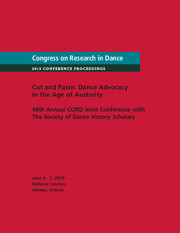No CrossRef data available.
Article contents
Almée or Salomé?: Hybrid Dances of the East, 1890–1930
Published online by Cambridge University Press: 04 January 2013
Abstract
The changing economic and artistic milieu of Western professional entertainment from 1890 to 1930 provided a liminal space for performances of “Eastern dance” by women of both Middle Eastern and non–Middle Eastern descent. In denning their performance personas and in articulating their hybrid dance techniques and presentations, these artists engaged in a fluid process that reflects the ever-changing reinscription of the relationship between the consumers of the West and the East they envision. This paper explores the nuances of this complex interaction through the careers and performance experiences of both Eastern and Western dancers.
- Type
- Research Article
- Information
- Copyright
- Copyright © The Author(s) 2007


